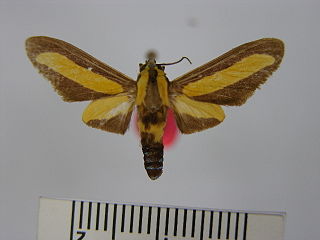Prussian Blue was an American white nationalist, Neo-Nazi pop duo formed of Lynx Vaughan Gaede and Lamb Lennon Gaede, fraternal twins born on June 30, 1992, in Bakersfield, California. The duo Prussian Blue was formed in early 2003 by their mother April Gaede. The twins referred to the Holocaust as a myth and promoted Holocaust denial and their group was described as racist and white supremacist.
Elysius is a fictional character appearing in American comic books published by Marvel Comics.
Amsacta is a genus of tiger moths in the family Erebidae erected by Francis Walker in 1855. The genus contains several species that need a review.
Elysius is a genus of moths in the family Erebidae. The genus was erected by Francis Walker in 1855.

Ormetica is a genus of moths in the family Erebidae.
Pheia is a genus of moths in the subfamily Arctiinae erected by Francis Walker in 1854.

Melipotis is a genus of moths in the family Erebidae first described by Jacob Hübner in 1818.

Procridinae is a subfamily of the family Zygaenidae.
Guillermo "Bill" Gaede is an Argentine engineer and programmer who is best known for Cold War industrial spying conducted while he worked at Advanced Micro Devices (AMD) and Intel Corporation (Intel). While at AMD, he provided the Cuban government with technical information from the semiconductor industry which the Cubans passed on to the Soviet bloc, primarily to the Soviet Union and East Germany. In 1992, Gaede turned himself over to the Central Intelligence Agency (CIA), which placed him in contact with the Federal Bureau of Investigation (FBI). The FBI began working with Gaede in a counter-espionage operation intended to penetrate Cuban intelligence using his contacts on the island. During this time Gaede obtained work at Intel Corp. in Chandler, Arizona. Intel Security discovered the nature of his activities at AMD and terminated him, but not before Gaede filmed Intel's state-of-the-art Pentium process from home.
Max Gaede was a German engineer and entomologist of international fame who described several hundred of new species of Lepidoptera, mainly African Noctuidae.

Armee-Abteilung Gaede / Armee-Abteilung B was an army level command of the German Army in World War I. It served on the Western Front throughout its existence and formed the extreme left wing.
Amsacta nigrisignata is a moth of the family Erebidae. It was described by Max Gaede in 1923. It is found in mainly in Ethiopia, but also other parts of Africa.
Elysius carbonarius is a moth of the family Erebidae. It was described by Paul Dognin in 1891. It is found in Bolivia and Peru.

Ormetica flavobasalis is a moth of the family Erebidae. It was described by Max Gaede in 1923. It is found in Bolivia.
Afrojavanica kostlani is a moth in the family Erebidae. It was described by Max Gaede in 1923. It is found in Ethiopia and Rwanda.
Spilosoma flavidior is a moth in the family Erebidae. It was described by Max Gaede in 1923. It is found in the Afrotropics.
A molecular drag pump is a type of vacuum pump that utilizes the drag of air molecules against a rotating surface. The most common sub-type is the Holweck pump, which contains a rotating cylinder with spiral grooves which direct the gas from the high vacuum side of the pump to the low vacuum side of the pump. The older Gaede pump design is similar, but is much less common due to disadvantages in pumping speed. In general, molecular drag pumps are more efficient for heavy gasses, so the lighter gasses will make up the majority of the residual gasses left after running a molecular drag pump.




